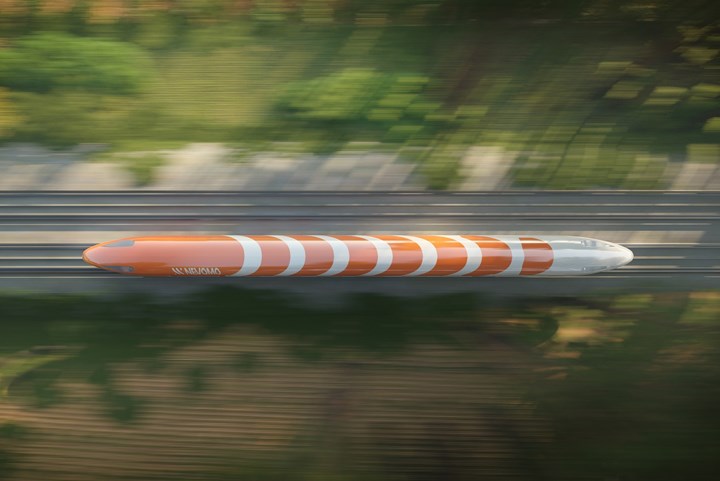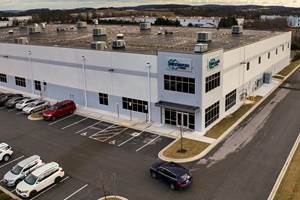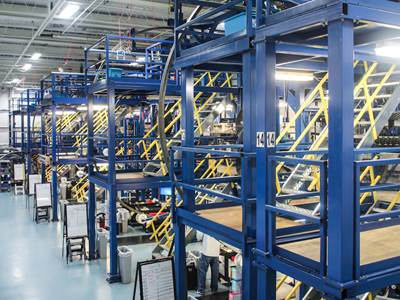Magrail technology to undergo feasibility testing in Italy
An MOU between Rete Ferroviaria Italiana and Nevomo aids to verify the feasibility of the composite hyperloop-inspired transportation technology, with a goal to eventually integrate it with European railway systems.

Magrail technology, visualized in the artist rendition above, can be superimposed on, and integrated with, existing railway routes. All photo credit: Nevomo
Rete Ferroviaria Italiana (Rome, Italy), the Ferrovie dello Stato Italiane Group company responsible for managing the national railway infrastructure, and Nevomo (formerly Hyper Poland, Warsaw, Poland) have signed a Memorandum of Understanding (MOU) to verify the technical and economic feasibility of superposing magrail technology — which will use composite materials for both vehicle components and track infrastructure — on existing railway infrastructures. The agreement also mentions technology acceleration, aimed at integrating it with the railway system.
Magrail, a hyperloop-inspired transportation technology, is expected to become a new high-speed transport system superposed on, and integrated with, existing railway corridors. It will enable the introduction of a new mode of propulsion with linear motors and a new interface between newly designed vehicles and the infrastructure, based on frictionless magnetic levitation. From a technical point of view, it will allow for interchangeable operations of conventional railway rolling stock, as well as new, faster, magnetic-levitating vehicles on the same line. The latter vehicles will be up to 75% faster than the former vehicles on the same route alignment. The system is expected to improve the performance and efficiency of existing railway corridors at moderate capital expenditure levels and with lower operational costs.
Within the vehicle, composite components are mainly made of glass fiber-epoxy laminates. Such a material was chosen due to the low- and high-frequency electromagnetic field sources which could interfere with carbon fiber. Moreover, aramid fibers were also used on some edges. The components include the housings for the motor parts, electronics, other minor subsystems and some loaded elements in the vehicle. In the next iteration, Nevomo says it aims to use the composites to a greater extent, since the current project is focused on other core technologies being developed for magrail and hyperloop applications.
In line with these verification activities, the two companies will apply for funding from the EU to conduct the first full-scale magrail system pilot on a test track in Bologna San Donato, which is owned by RFI. This will be the last stage of testing, which is expected to trigger the conformity assessment procedures needed to implement the magrail technology commercially in Europe. It is also expected that magrail will be compatible with the coexisting underlying railway system and will enable conventional and high-speed railway transport to be upgraded, without the need to build new infrastructures.
“The magrail technology we are developing allows us to implement sustainable mobility by transforming the transportation landscape into an efficient and emission-free system. The preliminary feasibility study of magrail technology, conducted in cooperation with our partner, IDOM, shows that the benefits of implementing magrail technology will be significant, both in economic and social terms,” says Przemek Paczek, CEO and co-founder of Nevomo. “We are happy that RFI, one of the European leaders in adopting advanced technological railway solutions, has placed its trust in us. Together, we have an opportunity to revolutionize rail transport.”

Nevomo says it has been successively gaining the trust of individual and institutional investors. Total funding (equity and grants) raised by the company has exceeded €7.9 million, including almost €1.3 million in its latest equity crowdfunding campaign on the U.K.-based platform Seedrs (London). So far, this fund-raising campaign has attracted more than 950 individual investors from more than 45 countries.
Further, this summer, Nevemo says it will start the construction of its first 1:1 scale test track in Poland.
Related Content
Kimya features Kimya PC-FR 3D filament for the transportation sector
Flame-retardant polycarbonate filament reaches EN45545 certification and meets REACH and RoHS standards for production of parts in railway, automotive, electronics.
Read MoreComposites reinvent transportation
Celebrating National Composites Week, CW shares ways in which composites continue to evolve mass transit.
Read MoreHexagon Purus opens new U.S. facility to manufacture composite hydrogen tanks
CW attends the opening of Westminster, Maryland, site and shares the company’s history, vision and leading role in H2 storage systems.
Read MoreLIST opens innovation center focusing on sustainable composite materials
The Sustainable Composite Materials and Manufacturing Innovation Centre (SCMM) will be supported by major players in rail, aerospace, automotive and space to transition sustainable composites research to commercialization.
Read MoreRead Next
Virgin Hyperloop unveils location for Hyperloop Certification Center
Virgin Hyperloop aims to achieve safety certification by 2025, and commercial operations beginning in 2030.
Read More“Structured air” TPS safeguards composite structures
Powered by an 85% air/15% pure polyimide aerogel, Blueshift’s novel material system protects structures during transient thermal events from -200°C to beyond 2400°C for rockets, battery boxes and more.
Read MorePlant tour: A&P, Cincinnati, OH
A&P has made a name for itself as a braider, but the depth and breadth of its technical aptitude comes into sharp focus with a peek behind usually closed doors.
Read More


















.jpg;maxWidth=300;quality=90)







